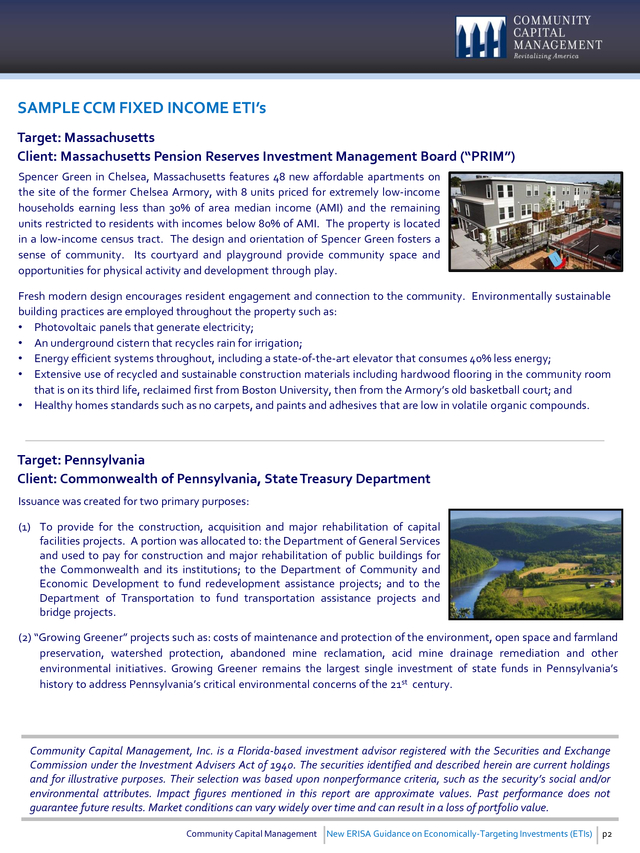Description
NEW ERISA GUIDANCE ON ECONOMICALLYTARGETED INVESTMENTS (ETIs)
WHAT ARE ETIs?
ETIs are investments:
• selected for the benefits they create in addition to the investment return
to the employee benefit plan investor.
• seeking to achieve superior market-rate risk-adjusted returns while
financing activities that promote economic development.
• assisting in the economic stimulation and improvement of a specific
geography while earning a financial return.
“Investing in the best interests
of a retirement plan and in the
growth of a community can go
hand in hand.”
-Thomas E. Perez, U.S.
Secretary of Labor
October 22, 2015
WHAT DOES THE NEW ERISA GUIDANCE MEAN FOR INVESTORS?
The new guidance, Interpretive Bulletin 2015-01, confirms the department’s longstanding view from IB 94-1 that
fiduciaries may not accept lower expected returns or take on greater risk in order to secure collateral benefits, but may
take such benefits into account as “tiebreakers” when investments are otherwise equal with respect to their economic
and financial characteristics. The guidance also acknowledges that environmental, social, and governance (ESG)
factors may have a direct relationship to the economic and financial value of an investment. When they do, these
factors are more than just tiebreakers, but rather are proper components of the fiduciary’s analysis of the economic and
financial merits of competing investment choices.1
HOW DOES CCM CUSTOMIZE A MARKET-RATE, FIXED INCOME ETI PORTFOLIO
FOR ERISA PORTFOLIOS?
Founded in 1998, Community Capital Management (CCM) specializes in managing fixed income ETI portfolios.
CCM is one of the largest fixed income ESG/impact investing managers with $2.1 billion in assets. Since its inception, the firm has invested over $6.8 billion in ESG/impact initiatives nationwide on behalf of its clients which include banks, public funds, religious organizations, foundations, registered and unregistered funds, and high net worth investors. While various terminology may be used to describe ETIs, at CCM, we use the terms “ETI” and “impact investing” interchangeably.
Furthermore, the firm’s overriding strategy is to build bottom-up, market-rate portfolios of highly liquid bonds which incorporate the “environmental” and “social” aspects of ESG. In customizing a market-rate, fixed income ETI portfolio, CCM’s first step is determining the client’s investment objectives and goals. The next step is establishing a performance benchmark, typically the Barclays U.S. Aggregate Bond Index.
The third step is establishing any geographic targeting. CCM then analyzes the amount of potential investment and time horizon for deployment. On a quarterly basis, clients receive financial reports as well as a customized impact report.
The impact report details the economic impact of each security and provides a quantifiable use of bond proceeds analysis and breakdown of what the investments are financing (i.e., number of affordable rental housing units, number of home mortgages for low- and moderate-income people, dollar amount of loans financing economic development projects, and examples of small businesses financed, among other detailed impact analysis). FOR MORE INFORMATION, PLEASE CONTACT: Jamie Horwitz Director of Marketing jhorwitz@ccmfixedincome.com 877-272-1977 / www.ccmfixedincome.com 1http://www.dol.gov/opa/media/press/ebsa/EBSA20152045.htm; emphasis by CCM; ERISA: Employee Retirement Income Security Act of 1974 Community Capital Management New ERISA Guidance on Economically-Targeting Investments (ETIs) p1 . SAMPLE CCM FIXED INCOME ETI’s Target: Massachusetts Client: Massachusetts Pension Reserves Investment Management Board (“PRIM”) Spencer Green in Chelsea, Massachusetts features 48 new affordable apartments on the site of the former Chelsea Armory, with 8 units priced for extremely low-income households earning less than 30% of area median income (AMI) and the remaining units restricted to residents with incomes below 80% of AMI. The property is located in a low-income census tract. The design and orientation of Spencer Green fosters a sense of community. Its courtyard and playground provide community space and opportunities for physical activity and development through play. Fresh modern design encourages resident engagement and connection to the community.
Environmentally sustainable building practices are employed throughout the property such as: • Photovoltaic panels that generate electricity; • An underground cistern that recycles rain for irrigation; • Energy efficient systems throughout, including a state-of-the-art elevator that consumes 40% less energy; • Extensive use of recycled and sustainable construction materials including hardwood flooring in the community room that is on its third life, reclaimed first from Boston University, then from the Armory’s old basketball court; and • Healthy homes standards such as no carpets, and paints and adhesives that are low in volatile organic compounds. Target: Pennsylvania Client: Commonwealth of Pennsylvania, State Treasury Department Issuance was created for two primary purposes: (1) To provide for the construction, acquisition and major rehabilitation of capital facilities projects. A portion was allocated to: the Department of General Services and used to pay for construction and major rehabilitation of public buildings for the Commonwealth and its institutions; to the Department of Community and Economic Development to fund redevelopment assistance projects; and to the Department of Transportation to fund transportation assistance projects and bridge projects. (2) “Growing Greener” projects such as: costs of maintenance and protection of the environment, open space and farmland preservation, watershed protection, abandoned mine reclamation, acid mine drainage remediation and other environmental initiatives. Growing Greener remains the largest single investment of state funds in Pennsylvania’s history to address Pennsylvania’s critical environmental concerns of the 21st century. Community Capital Management, Inc.
is a Florida-based investment advisor registered with the Securities and Exchange Commission under the Investment Advisers Act of 1940. The securities identified and described herein are current holdings and for illustrative purposes. Their selection was based upon nonperformance criteria, such as the security’s social and/or environmental attributes.
Impact figures mentioned in this report are approximate values. Past performance does not guarantee future results. Market conditions can vary widely over time and can result in a loss of portfolio value. Community Capital Management New ERISA Guidance on Economically-Targeting Investments (ETIs) p2 .
CCM is one of the largest fixed income ESG/impact investing managers with $2.1 billion in assets. Since its inception, the firm has invested over $6.8 billion in ESG/impact initiatives nationwide on behalf of its clients which include banks, public funds, religious organizations, foundations, registered and unregistered funds, and high net worth investors. While various terminology may be used to describe ETIs, at CCM, we use the terms “ETI” and “impact investing” interchangeably.
Furthermore, the firm’s overriding strategy is to build bottom-up, market-rate portfolios of highly liquid bonds which incorporate the “environmental” and “social” aspects of ESG. In customizing a market-rate, fixed income ETI portfolio, CCM’s first step is determining the client’s investment objectives and goals. The next step is establishing a performance benchmark, typically the Barclays U.S. Aggregate Bond Index.
The third step is establishing any geographic targeting. CCM then analyzes the amount of potential investment and time horizon for deployment. On a quarterly basis, clients receive financial reports as well as a customized impact report.
The impact report details the economic impact of each security and provides a quantifiable use of bond proceeds analysis and breakdown of what the investments are financing (i.e., number of affordable rental housing units, number of home mortgages for low- and moderate-income people, dollar amount of loans financing economic development projects, and examples of small businesses financed, among other detailed impact analysis). FOR MORE INFORMATION, PLEASE CONTACT: Jamie Horwitz Director of Marketing jhorwitz@ccmfixedincome.com 877-272-1977 / www.ccmfixedincome.com 1http://www.dol.gov/opa/media/press/ebsa/EBSA20152045.htm; emphasis by CCM; ERISA: Employee Retirement Income Security Act of 1974 Community Capital Management New ERISA Guidance on Economically-Targeting Investments (ETIs) p1 . SAMPLE CCM FIXED INCOME ETI’s Target: Massachusetts Client: Massachusetts Pension Reserves Investment Management Board (“PRIM”) Spencer Green in Chelsea, Massachusetts features 48 new affordable apartments on the site of the former Chelsea Armory, with 8 units priced for extremely low-income households earning less than 30% of area median income (AMI) and the remaining units restricted to residents with incomes below 80% of AMI. The property is located in a low-income census tract. The design and orientation of Spencer Green fosters a sense of community. Its courtyard and playground provide community space and opportunities for physical activity and development through play. Fresh modern design encourages resident engagement and connection to the community.
Environmentally sustainable building practices are employed throughout the property such as: • Photovoltaic panels that generate electricity; • An underground cistern that recycles rain for irrigation; • Energy efficient systems throughout, including a state-of-the-art elevator that consumes 40% less energy; • Extensive use of recycled and sustainable construction materials including hardwood flooring in the community room that is on its third life, reclaimed first from Boston University, then from the Armory’s old basketball court; and • Healthy homes standards such as no carpets, and paints and adhesives that are low in volatile organic compounds. Target: Pennsylvania Client: Commonwealth of Pennsylvania, State Treasury Department Issuance was created for two primary purposes: (1) To provide for the construction, acquisition and major rehabilitation of capital facilities projects. A portion was allocated to: the Department of General Services and used to pay for construction and major rehabilitation of public buildings for the Commonwealth and its institutions; to the Department of Community and Economic Development to fund redevelopment assistance projects; and to the Department of Transportation to fund transportation assistance projects and bridge projects. (2) “Growing Greener” projects such as: costs of maintenance and protection of the environment, open space and farmland preservation, watershed protection, abandoned mine reclamation, acid mine drainage remediation and other environmental initiatives. Growing Greener remains the largest single investment of state funds in Pennsylvania’s history to address Pennsylvania’s critical environmental concerns of the 21st century. Community Capital Management, Inc.
is a Florida-based investment advisor registered with the Securities and Exchange Commission under the Investment Advisers Act of 1940. The securities identified and described herein are current holdings and for illustrative purposes. Their selection was based upon nonperformance criteria, such as the security’s social and/or environmental attributes.
Impact figures mentioned in this report are approximate values. Past performance does not guarantee future results. Market conditions can vary widely over time and can result in a loss of portfolio value. Community Capital Management New ERISA Guidance on Economically-Targeting Investments (ETIs) p2 .













